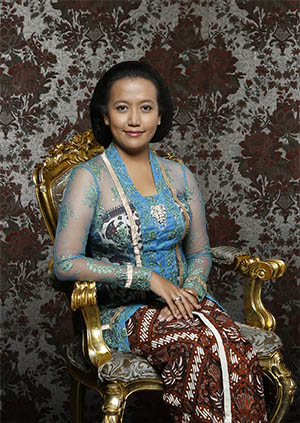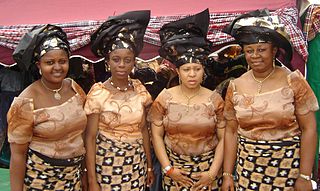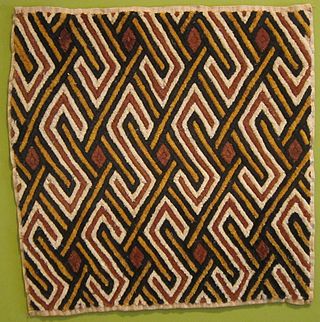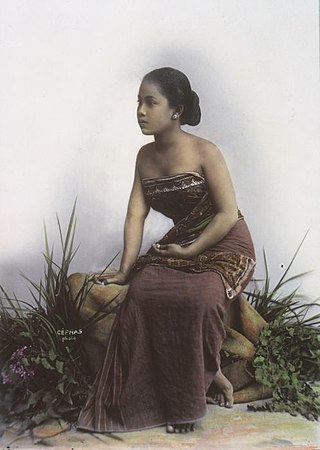History
During the second half of the 19th Century, Javanese batik print was introduced to West Africa. Wax print was based on Javanese batik print. African soldiers took cloth that was brightly colored with them after serving in Indonesia. This introduced local production which was slow and laborious because of the traditional process of production.
Akosombo Textiles Limited now Akosombo Industrial Company Limited [5] was established in 1967. [2] A new production line ABC (A. Brunschweiler & Company) [6] Wax opened a new facility at ATL to produce a standard wax range for the Ghanaian local market. [7] ABC over the past 100 years has been synonymous with textile manufacturing in Africa and Europe for English Wax.
In December 2005 ABC's new production facility in Ghana was officially inaugurated at Akosombo Textiles Limited. ABC standard has been printed in Ghana since 2006 by ATL as a collaboration between ABC, UK and ATL. [8] The decision to move the production of Standard to Ghana was to meet the changing demand of local African consumers.
The production of high quality Standard wax in Ghana during 2006/7 led to the transfer of ABC products such as Superwax, Handblock and Premium, and resulted in the final closure of the Manchester production facility in December 2007. [8]

Batik is an Indonesian technique of wax-resist dyeing applied to the whole cloth. This technique originated from the island of Java, Indonesia. Batik is made either by drawing dots and lines of the resist with a spouted tool called a canting, or by printing the resist with a copper stamp called a cap. The applied wax resists dyes and therefore allows the artisan to colour selectively by soaking the cloth in one colour, removing the wax with boiling water, and repeating if multiple colours are desired.

Kente refers to a Ghanaian textile, made of handwoven cloth, strips of silk and cotton. Historically the fabric was worn in a toga-like fashion by royalty among ethnic groups such as the Ashanti and Ewe. It is also worn by queens, princesses and women of Dagbon. In modern day Ghana, the wearing of kente cloth has become widespread to commemorate special occasions, with highly sought-after kente brands led by master weavers.

A sarong or a sarung is a large tube or length of fabric, often wrapped around the waist, worn in Southeast Asia, South Asia, Western Asia, Northern Africa, East Africa, West Africa, and on many Pacific islands. The fabric often has woven plaid or checkered patterns, or may be brightly colored by means of batik or ikat dyeing. Many modern sarongs have printed designs, often depicting animals or plants. Different types of sarongs are worn in different places in the world, notably the lungi in the Indian subcontinent and the izaar in the Arabian Peninsula.

The dashiki is a colorful garment that covers the top half of the body, worn mostly in West Africa. It is also known as a Kitenge in East Africa and is a common item of clothing in Tanzania and Kenya. It has formal and informal versions and varies from simple draped clothing to fully tailored suits. A common form is a loose-fitting pullover garment, with an ornate V-shaped collar, and tailored and embroidered neck and sleeve lines. It is frequently worn with a brimless kufi cap and pants. It has been popularized and claimed by communities in the African diaspora, especially African Americans.

A kebaya is an upper garment traditionally worn by women in Southeast Asia, notably in Brunei, Indonesia, Malaysia, Singapore and Southern Thailand. Outside of Southeast Asia, it is worn by Javanese, Malays and Portuguese Eurasians in Australian Cocos Islands and Christmas Island, coastal India and Sri Lanka, Macau as well as South Africa.

The wrapper, lappa, or pagne is a colorful garment widely worn in West Africa by both men and women. It has formal and informal versions and varies from simple draped clothing to fully tailored ensembles. The formality of the wrapper depends on the fabric used to create or design it.

African textiles are textiles from various locations across the African continent. Across Africa, there are many distinctive styles, techniques, dyeing methods, and decorative and functional purposes. These textiles hold cultural significance and also have significance as historical documents of African design.

Edcon Limited was a retail company based in Johannesburg, South Africa. Its subsidiaries included Edgars, a department store with 203 branches. In 2020, the Competition Tribunal approved the sale of the Edgars division to Retailability (pty) Ltd, and Jet to The Foschini Group.
The Volta River Authority (VRA) is the main generator and supplier of electricity in Ghana. They are also the responsible for the maintenance of the hydro power supply plant.

Malaysian batik is batik textile art in Malaysia, especially on the east coast of Malaysia. The most popular motifs are leaves and flowers. Malaysian batik depicting humans or animals are rare because Islam norms forbid animal images as decoration. However, the butterfly theme is a common exception. Malaysian batik is also famous for its geometrical designs, such as spirals. The method of Malaysian batik making is also quite different from those of Indonesian Javanese batik, the pattern is larger and simpler, it seldom or never uses canting to create intricate patterns and relies heavily on brush painting method to apply colours on fabrics. The colours also tend to be lighter and more vibrant than the deep coloured Javanese batik.

The petroleum industry of Ghana is regulated by the state-owned Ghana National Petroleum Corporation (GNPC) and administered by the state-owned Ghana Oil Company (GOIL).
Industry in Ghana accounts for about 24.5% of total GDP. However, Ghana's industrial production is rising at a 7.8% rate, giving it the 38th fastest growing industrial production in the world due to government industrialization policies.
Iwan Tirta was an Indonesian batik fashion designer. Tirta trained as a lawyer, but became an internationally known designer. He is credited with beginning the early revival of batik design during the 1970s and 1980s. He also became an Indonesian and Javanese cultural advocate, as well as a food consultant, later in his career.

The national costume of Indonesia is the national costume that represents the Republic of Indonesia. It is derived from Indonesian culture and Indonesian traditional textile traditions. Today the most widely recognized Indonesian national costumes include batik and kebaya, although originally those costumes mainly belong within the island of Java and Bali, most prominently within Javanese, Sundanese and Balinese culture. Since Java has been the political and population center of Indonesia, folk costume from the island has become elevated into national status.

Printex Limited is a privately owned textile manufacturing company headquartered in Accra, the capital of Ghana, with over 500 employees. The company was established in 1958 as Millet Textile Corporation (MTC), producing mainly terry towels.

African wax prints, Dutch wax prints or Ankara, are omnipresent and common materials for clothing in West Africa and Central Africa. They were introduced to West and Central Africans by Dutch merchants during the 19th century, who took inspiration from native Indonesian technique and Akwete cloth designs. They began to adapt their designs and colours to suit the tastes of the African market. They are industrially produced colourful cotton cloths with batik-inspired printing. One feature of these materials is the lack of difference in the colour intensity of the front and back sides. The wax fabric can be sorted into categories of quality due to the processes of manufacturing.

The Vlisco Group designs, produces and distributes fashion fabrics, especially of the African wax print style, for the West and Central African market and African consumers in global metropolitan cities. Founded in Helmond, The Netherlands, in 1846, the Vlisco Group and their fabrics have grown into an essential part of African culture, receiving widespread attention from the art, design and fashion worlds. Vlisco Group's brand portfolio consists of four brands: Vlisco, Woodin, Uniwax and GTP. The company's head office, as well as the design and production facilities for the Vlisco brand, are located in Helmond. For the other brands these facilities are based in Ghana and Ivory Coast. The Vlisco Group has eight sales offices in numerous African countries and around 2,700 employees.

Kemben is an Indonesian female torso wrap historically common in Java, Bali, and other part of Indonesian archipelago. It is made by wrapping a piece of kain (clothes), either plain, batik printed, velvet, or any type of fabrics, covering the chest wrapped around the woman's torso.

Amarachi Nwosu is a Nigerian-American photographer, visual artist, filmmaker, writer and speaker currently based in New York City. She is also the founder of Melanin Unscripted, a creative platform and agency aimed to dismantle stereotypes and blur cultural lines by exposing complex identities and cultures around the world. Her debut documentary "Black in Tokyo" premiered at the International Center of Photography at the ICP Museum, New York City in 2017 and she has also screened the film in Tokyo, Japan at Ultra Super New Gallery in Harajuku.
'Recover Textile Systems, mainly known as Recover™, is a materials science company and producer of mechanically recycled cotton and recycled cotton blends, created in 2020 with headquarters in Banyeres de Mariola, Spain.
















